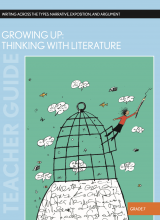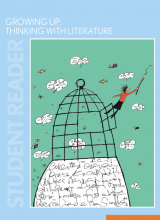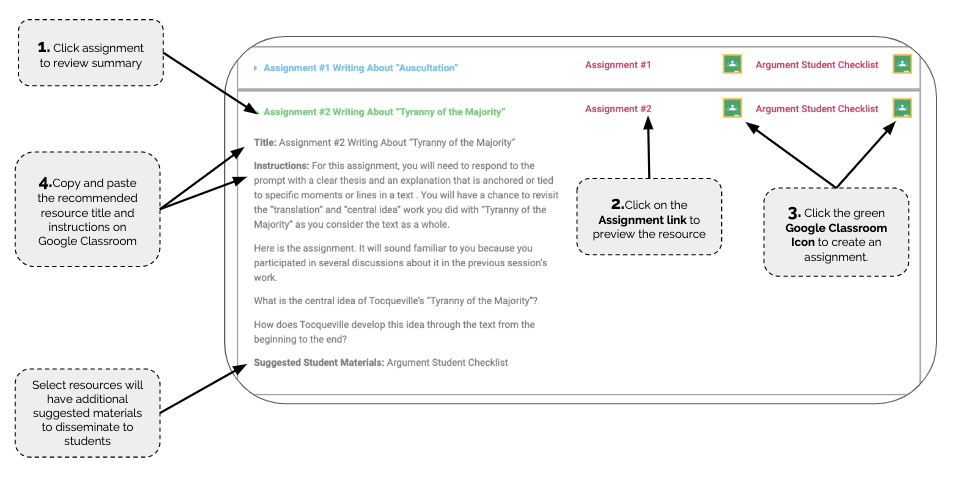Growing Up: Thinking With Literature - Grade 7
Arthur Applebee’s notion of “curriculum as conversation” plays an important role in this multitextual study where students read, write about, and write like texts united by the theme of growing up. During the unit, students will work carefully with texts by Alberto Alvaro Ríos, bell hooks, Richard Wright, and lê thi diem thúy. This close reading work provides a foundation for the heart of the study: the students’ own writing projects. In addition to writing text-based arguments and crafting an informative essay like Rios’, students will take on a “little stories” narrative writing project. At the end of this project, student writings are compiled and studied alongside the texts by Ríos, hooks, Wright, and lê. Students do essential comprehension and interpretive work with these compilations of “little stories” as they work to see the insights and questions their own writing brings to a text-anchored conversation about the idea and experience of “growing up.”


Table of Contents
Writing Tasks
Title: Studying Ríos: Assignment #1
Teacher Manual Instructions:
Session 2
Work Period
Place students in pairs or trios.
Students should work on “Studying Ríos: Assignment #1” in their small groups.
Use this time to confer with groups about this work.
Closing Meeting
Small-group discussions are an integral part of this unit’s work. Use this closing meeting to debrief the small-group work experience with the class.
Consider working with students to generate a two-column chart titled “Small-Group Work: Problems and Solutions.” Title the left column “Prob-lems” and the right column “Possible Solutions.” Encourage volunteers to offer short descriptions of problems that arose during the small-group work.
After you have the “Problems” list, ask the class to help you brainstorm possible solutions for each problem.
Title: Studying Ríos: Assignment #2
Teacher Manual Instructions:
Session 4
Place students in pairs or trios.
Working in their groups, students should share and discuss what they see as the most significant moment in the piece.
Use this time to confer with groups about this work.
Title: Writing Like Ríos: Assignment #3
Teacher Manual Instructions:
Session 5
Display a copy of “Writing Like Ríos: Assignment #3” for the class to see and distribute paper copies to students. (See Appendix for a copy-ready version.)
Review the assignment with the class and answer any questions students might have.
Use the remainder of the focus lesson to demonstrate for students what work on this assignment might look like. (For example, on the board or another display, you might list a few places that you know well, pick one to work with, show students how to create a map of that place, list some ideas for “reasons” to take a reader on a journey through that place, and then begin sketching out the piece.) Throughout your demonstration, it will be important to continue to stress the importance of taking readers “on a journey from and to and through someplace” in the way that Ríos does.
Tell the students that they will have this session’s work period to begin work on the assignment. They should plan on sharing their ideas and progress with the class during the closing meeting.
Work Period
- Students should begin work on the “Writing Like Ríos” assignment.
Title: Studying hooks: Assignment #1
Teacher Manual Instructions:
Session 12
Work Period
Place students in pairs or trios.
Students should use the small-group time to work on the second part of “Assignment #1,” creating character lists and brief summaries of who they are and what happens to them.
Use this time to confer with groups about this work.
Title: Studying hooks: Assignment #2
Teacher Manual Instructions:
Session 13
Work Period
Place students in groups of two or three.
Students should work in their small groups to complete “Assignment #2.”
Use this time to confer with groups about this work. Be sure to reserve about 15 minutes for the whole-class discussion during the closing meeting.
Title: Interpreting hooks: Assignment #3
Teacher Manual Instructions:
Session 13
Remind students that the purpose of this small-group work is to give students a chance to try out, revise, and refine the interpretations they will write during Session 16. Remind students to take notes during these discussions, as this will help them craft their written interpretive response.
Prepare for these discussions by pointing out the following things:
There is not a single correct answer to this question. There are many possible responses—some better than others.
A good interpretation clearly states a position.
A good interpretation contains an explanation that is anchored in specific sections of the text.
Give the small groups time to conduct their discussions.
Confer with groups about the work during this time. Be sure to remind
and model for the groups how to use the text during their discussions (for example, as a reference, to read from, to point to, etc.). Also, take time to show students how to jot notes and ideas down during these discussions. Remember, this is the first of several interpretive tasks students will take on during this unit. The experiences with this assignment will scaffold the challenges posed by the subsequent tasks.
Title: Interpreting hooks and Wright: Assignment #1
Teacher Manual Instructions:
Session 18
Place students in groups of two or three.
Remind the class that the purpose of the small-group work is to give students a chance to try out the interpretations they will write during Session 20. Remind students to take notes during these discussions, as this will help them craft their interpretive paper drafts. These notes will also help them participate in the whole-group conversation in the next session.
Take a few minutes to review the “Criteria for a Good Discussion.”
Give the groups time to conduct their discussions.
Confer with groups about the work during this time. Be sure to remind and model for the groups how to use the texts during these exchanges (for example, to reference, to read from, to point to, etc.). Also, take time to show students how to jot notes and ideas down during these discussions.
Title: Building Scenes: Assignment #2
Teacher Manual Instructions:
Session 23
Work Period
Place students in groups of two or three.
Give the small groups time to complete Part 1 of this assignment.
Use this time to confer with students about their work.
Title: Little Stories Writing Project
Teacher Manual Instructions:
Session 25
Work Period
Give students time to begin working on this assignment.
The class-generated short assignments list can give students some clear options for how to use this time.
Use this time to confer with students about their work.
Title: Studying lê: Assignment #1
Teacher Manual Instructions:
Session 33
Work Period
Place students groups of two or three.
Students should work in small groups to write their one-page retelling of the chapter.
Use this time to confer with groups about this work.
Reserve about 15 minutes for the closing meeting.
Title: Interpreting lê: Assignment #2
Teacher Manual Instructions:
Session 34
Work Period
Remind the class that the purpose of the small-group work for this assignment is to give students a chance to try out, revise, and refine the interpretations they will write during Session 36. Remind students to take notes during these discussions, as this will help them craft their interpretive papers.
Prepare for these discussions by pointing out the following things:
There is not a single correct answer to this question. There are many possible responses—some better than others.
A good interpretation clearly states a position.
A good interpretation contains an explanation that is anchored in specific sections of the text.
Give the groups time to conduct their discussions.
Confer with groups about the work during this time. Be sure to remind and model for the groups how to use the text during these exchanges (for ex- ample, to reference, to read from, to point to, etc.). Also, take time to show students how to jot notes and ideas down during these discussions.
Charts for Discussion
Title: List of Short Assignments
Teacher Manual Instructions:
Session 25
Take time to brainstorm with students a list of short assignments they might complete as they work on this assignment. Capture their list on a chart or other display. Use the sequencing of the sessions that follow and your own sense of your students’ needs to guide the development of this list.
Checks for Understanding
Title: Small-Group Work: Problems and Solutions
Teacher Manual Instructions:
Session 2
Closing Meeting
Small-group discussions are an integral part of this unit’s work. Use this closing meeting to debrief the small-group work experience with the class.
Consider working with students to generate a two-column chart titled “Small-Group Work: Problems and Solutions.” Title the left column “Problems” and the right column “Possible Solutions.” Encourage volunteers to offer short descriptions of problems that arose during the small-group work.
After you have the “Problems” list, ask the class to help you brainstorm possible solutions for each problem.
Title: Summary Map
Teacher Manual Instructions:
Session 3
Closing Meeting
Convene a whole-group discussion in which students collaborate to create a single, class version of the summary map of “A Rough Handshake” as outlined in “Studying Ríos: Assignment #1.” Capture this map on a chart.
Keep in mind that the point of this discussion and work is to help ensure that students know the piece well enough to try their hands at writing something like it.
Title: Revision Plans
Teacher Manual Instructions:
Session 9
Closing Meeting
Reconvene the class and ask volunteers to share some of their plans for revising their drafts.
Capture general summaries of these ideas on a chart. Be sure to push students for more detailed illustrations of their revision plans as needed.
Title: During Interpretive Discussions….
Teacher Manual Instructions:
Session 15
Reconvene the class and collaborate with the class to retrace the discussion. Work with students to notice what happened during the discussion: to notice places where a person extended or critiqued another person’s response; to notice what the facilitator did to focus and refocus the discussion; and to notice instances in which participants used the text to substantiate or explain a position or idea. In short, use this time to do the metacognitive work students need in order to be able to see what has to happen for this kind of work to get done well.
Capture these “noticings” on a chart titled “During Interpretive Discussions….” The goal here is to build a list that delineates what really good interpretive discussions look like.
Independent Reading
Title: Reading Log
Teacher Manual Instructions:
Independent Reading
As you transition to independent reading, discuss how students can keep a reading log. Show students how you would like them to set up and use their reading log to record their independent reading this year. An example of one way a reading log could be set up is provided nearby. You may choose to have students create a table in their notebooks, use a pre-made sheet, or a digital format.
Explain to students that they should make an entry in their log only after they have finished a book. You will need to negotiate with students how to handle the entry of magazine readings (for example, entire issues versus individual articles).
After students have set up the log, including proper headings, creating the grid, etc., show students how to make an entry.
Answer any questions students have about the reading log.
Begin independent reading.
Consider conducting individual reading conferences with students as they are engaged in independent reading. In No More Independent Reading Without Support, Debbie Miller and Barbara Moss (2013) suggest that during early conferences, you should listen to students and work to build trust: Ask students how they view reading and how they think of themselves as readers; ask what they are interested in. Over time you can ask more about what they are reading and about how you can help them or what they are struggling with. Use what you learn from these conversations to guide additional instruction with groups or with the class.
Title: Independent Reading – Individual Planning Sheet
Instructions:
Title: End of Marking Period Self-Assessment
Instructions:
Unit Resources
Title: Interpreting hooks and Wright: Assignment #1
Title: Scaffolds and Modifications: Descriptions and Use
